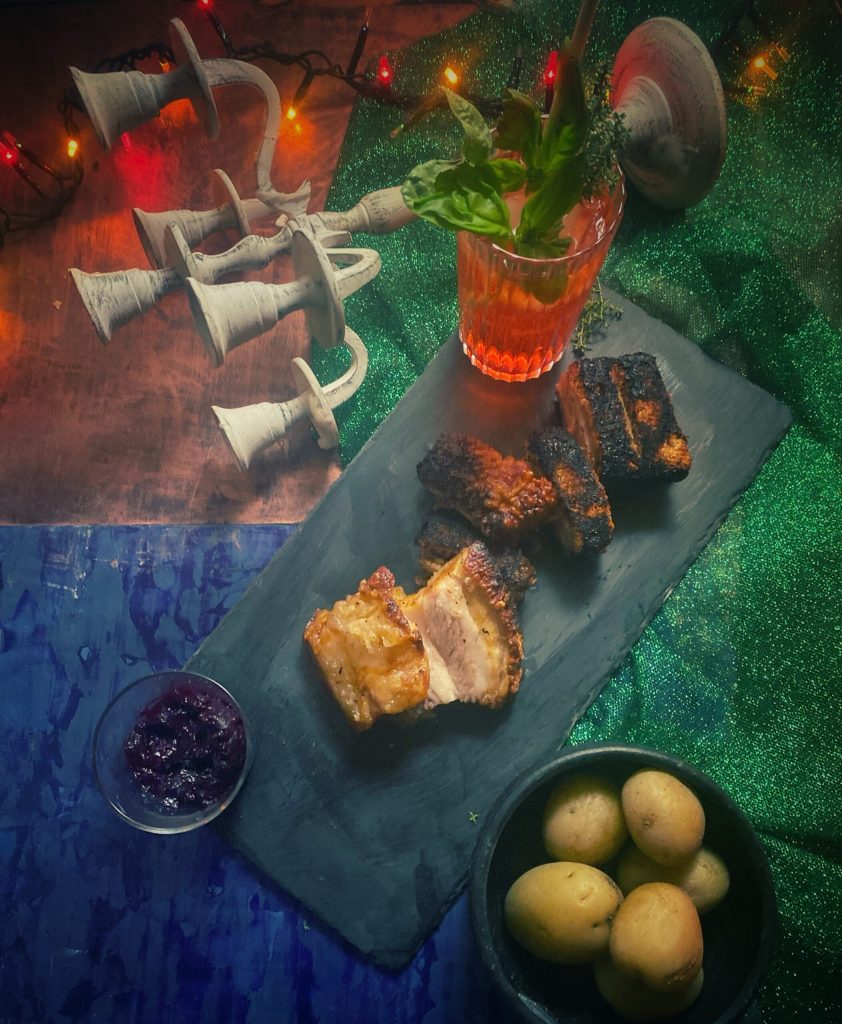The Ribbe, or roasted pork belly, is Norway’s most popular Christmas dish, accompanied by a myriad of choices for side dishes, such as boiled potatoes and gravy, surkål (sweet and sour cabbage) or rødkål (sweet and sour red cabbage), lingonsylt (lingonberry sauce with sugar), pork meatballs (medisterkaker), Christmas sausages (julepølser), and roasted apples or plums.
Along with lefse, the Norwegian bread.
While Eastern Norwegians celebrate Christmas with Ribbe, the western coast does so with lamb ribs called Pinnekjøtt.
Before the Reformation in 1537, Catholicism prohibited meat during Advent or Christmas Eve.
Therefore, there was (and still is for some) the tradition of fresh fish, lutefisk, and
persetorsk (pressed cod) on Christmas Eve.
The day after Christmas Eve, the fast could be broken, and meat was served. Because winters were extremely harsh, food was prepared to sustain people through the months and prevent hunger.
Therefore, the meat offered was exclusively cured meat, as fresh meat could not be preserved.
The recipe resembles another typical Scandinavian pork dish:

- Difficulty: Easy
- Cost: Cheap
- Rest time: 3 Days
- Preparation time: 10 Minutes
- Portions: 6 People
- Cooking methods: Oven
- Cuisine: Norwegian
- Seasonality: Christmas
Ingredients
- 4.4 lbs pork belly (with rind)
- to taste salt and pepper
Steps
Score the pork belly rind in a grid of small squares of 0.6 inches.
Rub the meat with salt and pepper.
Wrap in plastic wrap and refrigerate for at least a day, up to three days.
Place in a baking dish with 7 ounces of water – the meat should be elevated – and bake in the oven at 450°F for 45 minutes covered with foil.
Uncover, lower to 390°F and bake another hour.
Be careful not to burn the rind as happened to me!
Let rest for 20 minutes and serve with chosen sides.

Fil Rouge
In the photo, you find the ribbe accompanied by a cocktail named “Fil Rouge” whose recipe is inside the book by Ottavia Castellaro “Aromatiche da bere”.
In the photo, you find the ribbe accompanied by a cocktail named “Fil Rouge” whose recipe is inside the book by Ottavia Castellaro “Aromatiche da bere”.
🧵Ottavia tells us a story where the common thread of this drink is Thyme #erbaromatica, which with its aromatic hints creates a connection with the salinity of Tequila, the complexity of the citrus aperitif, the sweetness of hibiscus and basil sherbet, and the citrus notes of pink grapefruit soda, reminiscent of the Mexican Paloma.
🧵Ottavia tells us a story where the common thread of this drink is Thyme #erbaromatica, which with its aromatic hints creates a connection with the salinity of Tequila, the complexity of the citrus aperitif, the sweetness of hibiscus and basil sherbet, and the citrus notes of pink grapefruit soda, reminiscent of the Mexican Paloma.
What is sherbet❓
🔺 Sherbet or sharbat refers to a typical Middle Eastern and South Asian beverage made of fruit or flower petals, served cold; it can be served in a dense form and sipped with a spoon or diluted in water.
🔺 The most common ones are made from one or more ingredients, the most used elements are roses, sandalwood, gurhal (hibiscus), bael (wood apple), lemon, orange, pineapple, phalsa (a berry)
FAQ (Questions and Answers)
What is the recipe for medisterkaker?
For 2 people, about 15 meatballs
Time: preparation 15 min | Cooking time: 20-30 min
2 tablespoons of butter
500 g of ground pork
2-3 tablespoons of flour
3/4 cup of milk (or cold water)
1/2 teaspoon of ground nutmeg
1/2 teaspoon of ground ginger
1/2 teaspoon of ground pepper
1/2 teaspoon of salt
In a large bowl, mix the mince well, then add the milk (or water), a little at a time.
In a large pan and possibly deep enough, heat the butter.
With a spoon and your hand, form rather large balls (larger than a normal meatball) and place them in the pan.
Flatten them to make them more flat with the spatula and repeat with all the meat.
Cook the meatballs on each side until they are browned on both sides. Then, add some water, at least 1 cm in the pan, and keep the heat at medium temperature and let the meatballs absorb some water.
📚 For #poesianelpiatto for #radioviaggiandomangiando, the radio of the blog in its #podcast version, with the beautiful and profound poem “The Sea Inside” by R. Sampedro (from the film of the same name), to which I associate the complexity of tastes of the above cocktail.

